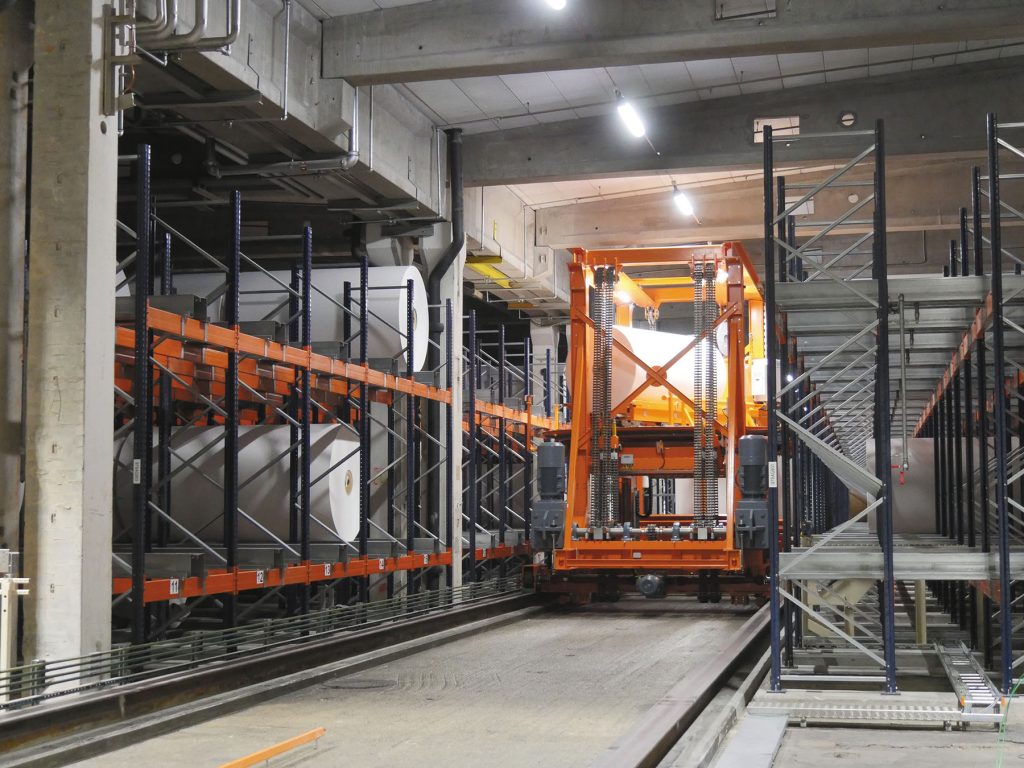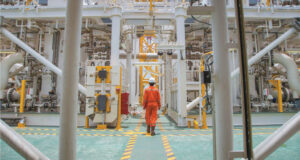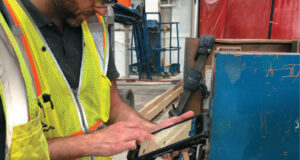MARK RUSHTON
Metsä Board’s Husum mill in Sweden is one of those classic mills that goes back a long way, at the same time retaining historical DNA that embraces the best in innovation. The recent installation of a completely automated warehousing system fits firmly into its dynamic history.
The Husum mill is situated on the High Coast in the municipality of Örnsköldsvik in northern Sweden and dates back to 1919, when it was first set up as a pulp mill by the influential Kempe family. The family were firm believers that “if you are going to do something, be the best at it,” and this mindset has stayed with the mill throughout its history.

Daniel Lundström, board production manager at Husum, says, “We have quite a heritage at the mill, and people are very proud to work here. The head of the Kempe family was a renowned businessman and landowner in the area, and after a fire at a sawmill, he decided the time was right to move into pulp. The company became very successful at it, using the latest in technology even in the early 1900s.”
Fast-forward to just over 100 years later and the mill, now owned by Metsä Board, is fully integrated, making top quality pulp for the market and making its own products in a highly sophisticated board operation. The mill is in the perfect location for pulp and board making: close to pristine forests for raw material of northern pine and adjacent to its own harbor for exporting its products.
“We pump around half of our pulp to the board mill, and the other half goes to the market from the harbor, which is right next to the mill. The harbor also comes in very handy for importing large pieces of new equipment and technology for our expansion programs,” adds Lundström.
Metsä Board recently ordered a new recovery boiler and turbine for the Husum mill with start-up estimated in the first half of 2022. This is a part of a renewal program at the mill and is also part of its strategy to continue profitable, organic growth in fresh fiber-based packaging materials.
THE HEART OF THE MILL
The mill produces around 730,000 metric tpy of bleached kraft pulp, about half of which goes for export, with the remainder being used for its board operation. It has two board machines: one relatively new machine started up in 2016, producing 400,000 metric tpy of folding boxboard; and the other producing 250,000 metric tpy of white kraftliner.
Top quality board is the heart of the mill. The main markets for its board are Europe and North America. The two board machines have trim widths of 6.50 m and run at speeds up to 1,300 m/min, and in grammage ranges from 70-365 gsm. “Production of fine paper at the mill ended completely in 2016, which makes us a 100 percent board producer,” says Lundström.
The mill’s products now include fully coated bleached folding boxboard with white back, fully coated OBA-free folding boxboard, coated and uncoated food service board, uncoated folding boxboard for the luxury market, and fully bleached white kraftliner. One recent addition to the mill has been a 100,000 metric tpy extrusion line, which has been added to serve the global food and food service packaging market.
“We get great feedback on our products,” says Lundström. “Our liners and food service boards are very well-received and our customers are particularly delighted by the quality and strength of our lightweight boards.
“We are very fortunate at Husum to have a supportive group behind us that enables us to install the best in technology; but even more important are the multi-skilled and dedicated teams working here who really know how to make the best in paperboard products.”
A REVOLUTION IN LOGISTICS
WAS NEEDED
With the start-up of the new board machine in 2016, quickly followed by the 100,000 metric tpy capacity extrusion line, the mill needed to take a good, hard look at its logistics operation, particularly its internal logistics, because the mill needed intermediate storage of board rolls. “We needed a buffer and a system to balance out the production coming from the board machine to then go onto the extrusion line for coating,” says Lundström. “This all has to happen at full production speed, so it was obvious that it could not be a manual operation using forklift trucks.
“An advantage with this mill is that we have a lot of existing buildings from when we were converting fine paper into cut-size products. However, the disadvantage was these buildings were not ideal for utilizing as an intermediate warehouse for the storage of large rolls waiting to be coated on the extruder. We needed a tailor-made solution to fit in with what we had.”
Metsä Board decided to bring in Finnish logistical experts in the pulp and paper industry Pesmel to design an automated system. The system would need to handle the logistics requirements of large rolls moving to and from the extruding line; it would also need to fit into the existing infrastructure and buildings around the board machine hall. “We chose Pesmel as we knew they had a lot of experience in moving and storing rolls for the paper industry and believed and trusted them to come up with a solution,” says Lundström.
The location chosen for the automated system was a disused sheeting hall next to the extruder line. This location posed a challenge in that its ceiling was only six meters in height. This meant that stacking rolls on top of each other as is usually done was out of the question.
Kaj Fahllund, pulp and paper logistics expert at Pesmel, says, “Normally, to store paper rolls of the size the Husum mill needed, a ceiling height of 15 meters (about 49 feet) would be the absolute minimum. These are big, heavy rolls we are talking about, at least 3 meters wide and around 6-8 tons in weight.
“The challenge was being able to move and store the rolls fast and efficiently, while completely eliminating the chance of damage. We decided the best way was to design a system where the rolls were kept in a horizontal position via channels, and fit them into two levels, thereby maximizing the space we had to play with.”
SCALABLE AND MODULAR
Pesmel designed a system to fit the existing storage hall based on its TransRoll automated storage concept. The system is versatile for any application because it is scalable and modular, so can be installed in tight, small spaces, as well as built for high storage where there is more space available. To make the most efficient use of the floor area, the design team chose asymmetric channel lengths of 24 and 17 meters to be served by a single stacker crane in the aisle between them. The whole system, including all features of handling and sorting, is controlled by Pesmel’s own WMS (warehouse management system).
The final result? The Husum mill now has a tailored, automated storage system that will successfully store 4,000 tons of board in a tight space of only 3,180 m2 with a ceiling height of six meters. At the same time, the system provides a handling capacity of 300 tons of board per hour.
“There were obviously the usual challenges that go with installing such a complex system as this, especially when you note that the board machines were running at full capacity as the installation took place,” says Lundström. “But after sorting out a few teething problems and getting to the top of the learning curve, we now have a system that is fully automated, fully functioning and fully optimized.
“The alternative would have been a lot of forklift trucks, and a lot of manual movements around the lines, with all the safety aspects and possible damage to rolls that that would involve,” he adds. “The line is now operating fully automatically and is running very smoothly. Another added advantage is that after the extruder, the coated mother rolls are cut with a slitter winder to make final customer rolls. These smaller rolls are fed back through the main roll handling system, which has now created a buffer for finished rolls.”
Mark Rushton is Paper360° senior editor and the editor of Tissue360°; contact him at [email protected].
 Paper 360
Paper 360


